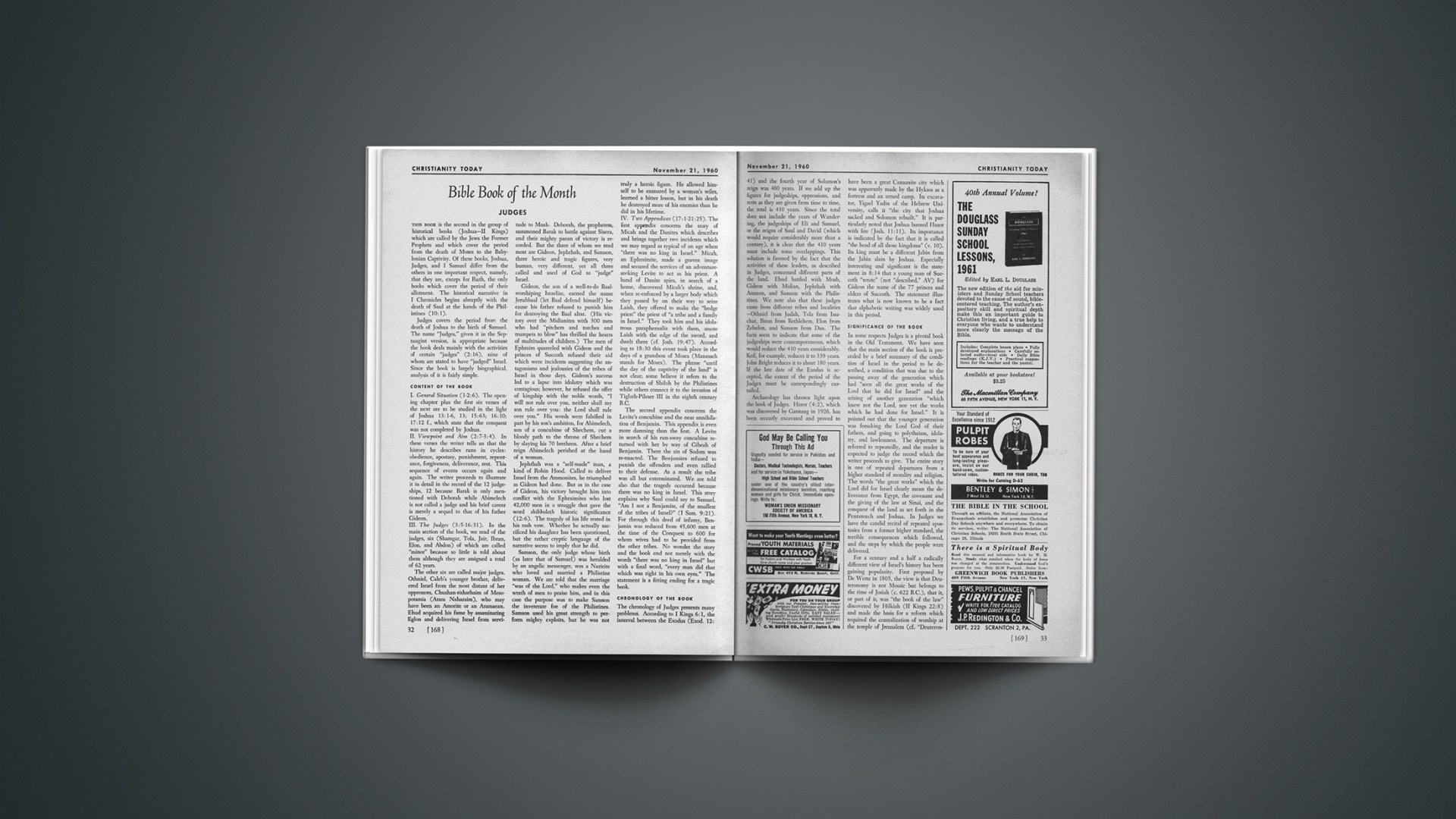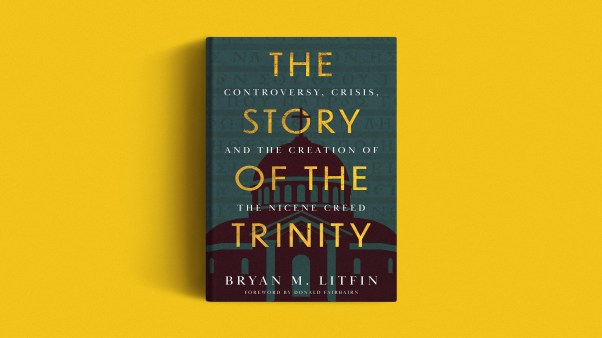This book is the second in the group of historical books (Joshua—II Kings) which are called by the Jews the Former Prophets and which cover the period from the death of Moses to the Babylonian Captivity. Of these books, Joshua, Judges, and I Samuel differ from the others in one important respect, namely, that they are, except for Ruth, the only books which cover the period of their allotment. The historical narrative in I Chronicles begins abruptly with the death of Saul at the hands of the Philistines (10:1).
Judges covers the period from the death of Joshua to the birth of Samuel. The name “Judges,” given it in the Septuagint version, is appropriate because the book deals mainly with the activities of certain “judges” (2:16), nine of whom are stated to have “judged” Israel. Since the book is largely biographical, analysis of it is fairly simple.
CONTENT OF THE BOOK
I. General Situation (1–2:6). The opening chapter plus the first six verses of the next are to be studied in the light of Joshua 13:1–6, 13; 15:63; 16:10; 17:12 f., which state that the conquest was not completed by Joshua.
II. Viewpoint and Aim (2:7–3:4). In these verses the writer tells us that the history he describes runs in cycles: obedience, apostasy, punishment, repentance, forgiveness, deliverance, rest. This sequence of events occurs again and again. The writer proceeds to illustrate it in detail in the record of the 12 judgeships, 12 because Barak is only mentioned with Deborah while Abimelech is not called a judge and his brief career is merely a sequel to that of his father Gideon.
III. The Judges (3:5–16:31). In the main section of the book, we read of the judges, six (Shamgar, Tola, Jair, Ibzan, Elon, and Abdon) of which are called “minor” because so little is told about them although they are assigned a total of 62 years.
The other six are called major judges. Othniel, Caleb’s younger brother, delivered Israel from the most distant of her oppressors, Chushan-rishathaim of Mesopotamia (Aram Naharaim), who may have been an Amorite or an Aramaean. Ebud acquired his fame by assassinating Eglon and delivering Israel from servitude to Moab. Deborah, the prophetess, summoned Barak to battle against Sisera, and their mighty paean of victory is recorded. But the three of whom we read most are Gideon, Jephthah, and Samson, three heroic and tragic figures, very human, very different, yet all three called and used of God to “judge” Israel.
Gideon, the son of a well-to-do Baal-worshiping Israelite, earned the name Jerubbaal (let Baal defend himself) because his father refused to punish him for destroying the Baal altar. (His victory over the Midianites with 300 men who had “pitchers and torches and trumpets to blow” has thrilled the hearts of multitudes of children.) The men of Ephraim quarreled with Gideon and the princes of Succoth refused their aid which were incidents suggesting the antagonisms and jealousies of the tribes of Israel in those days. Gideon’s success led to a lapse into idolatry which was contagious; however, he refused the offer of kingship with the noble words, “I will not rule over you, neither shall my son rule over you: the Lord shall rule over you.” His words were falsified in part by his son’s ambition, for Abimelech, son of a concubine of Shechem, cut a bloody path to the throne of Shechem by slaying his 70 brethren. After a brief reign Abimelech perished at the hand of a woman.
Jephthah was a “self-made” man, a kind of Robin Hood. Called to deliver Israel from the Ammonites, he triumphed as Gideon had done. But as in the case of Gideon, his victory brought him into conflict with the Ephraimites who lost 42,000 men in a struggle that gave the word shibboleth historic significance (12:6). The tragedy of his life rested in his rash vow. Whether he actually sacrificed his daughter has been questioned, but the rather cryptic language of the narrative seems to imply that he did.
Samson, the only judge whose birth (as later that of Samuel) was heralded by an angelic messenger, was a Nazirite who loved and married a Philistine woman. We are told that the marriage “was of the Lord,” who makes even the wrath of men to praise him, and in this case the purpose was to make Samson the inveterate foe of the Philistines. Samson used his great strength to perform mighty exploits, but he was not truly a heroic figure. He allowed himself to be ensnared by a woman’s wiles, learned a bitter lesson, but in his death he destroyed more of his enemies than he did in his lifetime.
IV. Two Appendices (17:1–21:25). The first appendix concerns the story of Micah and the Danites which describes and brings together two incidents which we may regard as typical of an age when “there was no king in Israel.” Micah, an Ephraimite, made a graven image and secured the services of an adventure-seeking Levite to act as his priest. A band of Danite spies, in search of a home, discovered Micah’s shrine, and, when re-enforced by a larger body which they passed by on their way to seize Laish, they offered to make the “hedge priest” the priest of “a tribe and a family in Israel.” They took him and his idolatrous paraphernalia with them, smote Laish with the edge of the sword, and dwelt there (cf. Josh. 19:47). According to 18:30 this event took place in the days of a grandson of Moses (Manasseh stands for Moses). The phrase “until the day of the captivity of the land” is not clear; some believe it refers to the destruction of Shiloh by the Philistines while others connect it to the invasion of Tiglath-Pileser III in the eighth century B.C.
The second appendix concerns the Levite’s concubine and the near annihilation of Benjamin. This appendix is even more damning than the first. A Levite in search of his run-away concubine returned with her by way of Gibeah of Benjamin. There the sin of Sodom was re-enacted. The Benjamites refused to punish the offenders and even rallied to their defense. As a result the tribe was all but exterminated. We are told also that the tragedy occurred because there was no king in Israel. This story explains why Saul could say to Samuel, “Am I not a Benjamite, of the smallest of the tribes of Israel?” (1 Sam. 9:21). For through this deed of infamy, Benjamin was reduced from 45,600 men at the time of the Conquest to 600 for whom wives had to be provided from the other tribes. No wonder the story and the book end not merely with the words “there was no king in Israel” but with a final word, “every man did that which was right in his own eyes.” The statement is a fitting ending for a tragic book.
CHRONOLOGY OF THE BOOK
The chronology of Judges presents many problems. According to 1 Kings 6:1, the interval between the Exodus (Exod. 12:41) and the fourth year of Solomon’s reign was 480 years. If we add up the figures for judgeships, oppressions, and rests as they are given from time to time, the total is 410 years. Since the total does not include the years of Wandering, the judgeships of Eli and Samuel, or the reigns of Saul and David (which would require considerably more than a century), it is clear that the 410 years must include some overlappings. This solution is favored by the fact that the activities of these leaders, as described in Judges, concerned different parts of the land. Ehud battled with Moab, Gideon with Midian, Jephthah with Ammon, and Samson with the Philistines. We note also that these judges came from different tribes and localities—Othniel from Judah, Tola from Issachar, Ibzan from Bethlehem, Elon from Zebulon, and Samson from Dan. The facts seem to indicate that some of the judgeships were contemporaneous, which would reduce the 410 years considerably. Keil, for example, reduces it to 339 years. John Bright reduces it to about 180 years. If the late date of the Exodus is accepted, the extent of the period of the Judges must be correspondingly curtailed.
Archaeology has thrown light upon the book of Judges. Hazor (4:2), which was discovered by Garstang in 1926, has been recently excavated and proved to have been a great Canaanite city which was apparently made by the Hyksos as a fortress and an armed camp. Its excavator, Yigael Yadin of the Hebrew University, calls it “the city that Joshua sacked and Solomon rebuilt.” It is particularly noted that Joshua burned Hazor with fire (Josh. 11:11). Its importance is indicated by the fact that it is called “the head of all those kingdoms” (v. 10). Its king must be a different Jabin from the Jabin slain by Joshua. Especially interesting and significant is the statement in 8:14 that a young man of Succoth “wrote” (not “described,” AV) for Gideon the name of the 77 princes and elders of Succoth. The statement illustrates what is now known to be a fact that alphabetic writing was widely used in this period.
SIGNIFICANCE OF THE BOOK
In some respects Judges is a pivotal book in the Old Testament. We have seen that the main section of the book is preceded by a brief summary of the condition of Israel in the period to be described, a condition that was due to the passing away of the generation which had “seen all the great works of the Lord that he did for Israel” and the arising of another generation “which knew not the Lord, nor yet the works which he had done for Israel.” It is pointed out that the younger generation was forsaking the Lord God of their fathers, and going to polytheism, idolatry, and lawlessness. The departure is referred to repeatedly, and the reader is expected to judge the record which the writer proceeds to give. The entire story is one of repeated departures from a higher standard of morality and religion. The words “the great works” which the Lord did for Israel clearly mean the deliverance from Egypt, the covenant and the giving of the law at Sinai, and the conquest of the land as set forth in the Pentateuch and Joshua. In Judges we have the candid recital of repeated apostasies from a former higher standard, the terrible consequences which followed, and the steps by which the people were delivered.
For a century and a half a radically different view of Israel’s history has been gaining popularity. First proposed by De Wette in 1805, the view is that Deuteronomy is not Mosaic but belongs to the time of Josiah (c. 622 B.C.), that it, or part of it, was “the book of the law” discovered by Hilkiah (2 Kings 22:8) and made the basis for a reform which required the centralization of worship at the temple of Jerusalem (cf. “Deuteronomy” in Bible Book of the Month, CHRISTIANITY TODAY, July 7, 1958, p. 37).
Support for the late dating is found in the obviously close resemblance between the teaching of Deuteronomy and that of the great prophets of the eighth and seventh centuries B.C. A major objection to the view, in addition to the plain affirmation in Deuteronomy of its Mosaic character, is that the historical books (Joshua—Kings) describe the history of the period they cover in the very terms which Deuteronomy predicts, namely, in terms of frequent departure from the law of Sinai. Consequently it became necessary for those who regard Deuteronomy as late to insist that the historical books were compiled and edited in “Deuteronomistic” circles. So critical scholars are accustomed to speak of Joshua-Kings as the “Deuteronomistic history,” which means that this great group of history books estimates the history which it records in terms of the ideas and standards of a far later period. To illustrate the point, I refer to a higher critical handling of Joshua 22, the story of the witness altar which the leaders of two and a half tribes declared emphatically was not intended to be a place of sacrifice. Critics themselves admitted that the altar would have been a “rebellion” or “transgression”: the law of the “central sanctuary” was instituted by Moses. So the advocates of the theory are obliged to treat Joshua 22 as “Deuteronomistic,” or even as “priestly” which places it still later in time. The stories, therefore, which describe actual conditions in the time of the Judges are, according to these scholars, set in a Deuteronomic framework which mistakenly represents them as apostasy from a standard introduced centuries later.
A prominent advocate of the above theory, Johannes Pedersen, said: “The strange thing, then, is that Israel in an essential degree came to deny her real history.” To us the even stranger thing is that for a century and a half critics of the Bible have been insistent in forcing on the Old Testament a theory which is so opposed to its own statements and viewpoint.
The book of Judges has a lesson which the present generation of Christians greatly needs. We are learning today at heavy cost that the failure of even a single generation to pass on to its successor its own precious heritage of faith and morals will have tragic results. The godlessness and delinquency in present day America is largely the result of the breakdown of Christian nurture in our homes, schools, and churches. It does not take long to train up a generation of whom it can be said, “and there arose another generation after them which knew not the Lord, nor yet the works which he had done for Israel.” The Communists in Russia and in China are strenuously engaged in the task of bringing into being a new generation which knows nothing of its past, which is a stranger to the culture which went before it. In other places, no such special training of the young people is needed. Let the children alone, leave them without discipline, allow them to “develop naturally,” we say, which is the basic idea in “progressive education”; and when they grow up it will be said of them, “every man did that which was right in his own eyes.” Christian example, Christian education, Christian nurture, are the supreme need today if Christianity is to meet triumphantly the forces of evil which challenge its very existence.
BIBLIOGRAPHY
The recently published Keil and Delitzsch Commentary is still one of the best expositions of the biblical text. The results of archaeological research are given in Garstang’s The Foundations of Bible History (1931) and more recently in Unger’s Archaeology of the Old Testament, and Free’s Archaeology and Bible History. Other sources are The Biblical Archaeologist and the Bulletin of the American Schools of Oriental Research. The critical interpretation of Judges is given in G. F. Moore’s treatise in The International Critical Commentary, by C. F. Burney in The Book of Judges, and also in the Introductions of S. R. Driver and of R. H. Pfeiffer. Other books which might be mentioned are H. H. Rowley From Joseph to Joshua, G. E. Wright Archaeology of the Bible, and the Rand-McNally Bible Atlas by Emil G. Kraeling.
OSWALD T. ALLIS
Wayne, Pennsylvania










